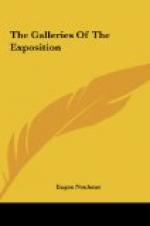Gallery 79.
Chase.
Balancing Duveneck’s gallery on the south, William M. Chase continues the Munich traditions, in the successful treatment of a variety of subjects for which he has always been famous. Closely associated with Duveneck, and showing all the rich qualities of the Munich men, Chase’s picturesque personality finds a reflection in his subjects, which all seem to have been chosen to give him an opportunity to display a certain bravado of handling which characterizes all of his work. The Chase collection gives a good idea of the career of this most useful of all American painters, who in an astonishingly active life has been teacher, friend, and counsellor to hundreds of the younger people in the field of art. His life has been most useful — always in the interest of the very best, with conspicuous success in aiding the uplift of American art. His still-lifes have for years been famous for their fidelity of interpretation of a variety of contrasting things, like fishes, copper bowls, and onions. No less interesting have been his portraits of the great mass of people who have sat for him. He has never been afraid of painting anything, and whatever it may be, he has treated it with great breadth, fine pictorial feeling, and charm of colour. His “Woman with the White Shawl” has become a classic during his lifetime, and some of his still-lifes are sufficient to serve as a permanent solid foundation for his reputation. Chase’s art, while decidedly academic, excels in esprit, in a certain elegant yet energetic expression which after all is nothing but the painter’s own personality reflected in his work. The delightful set of small landscapes of Italian and American subjects adds much interest in this collection, which is very well hung against an effective blue background.




